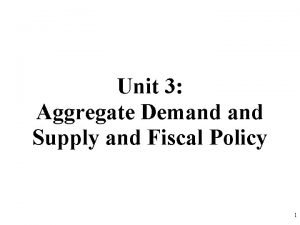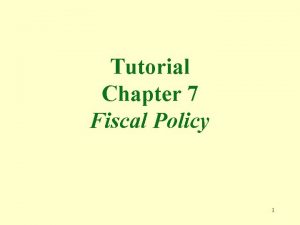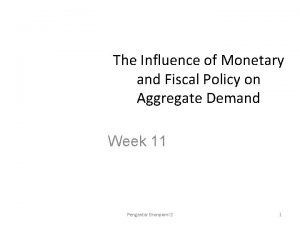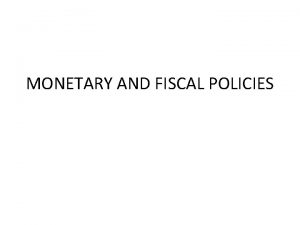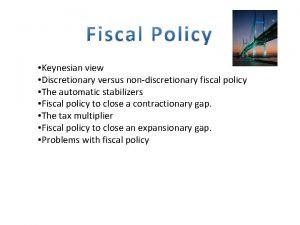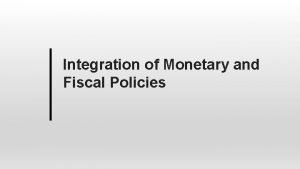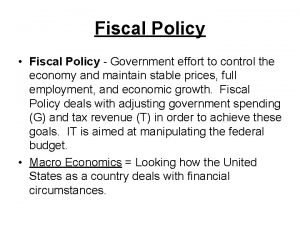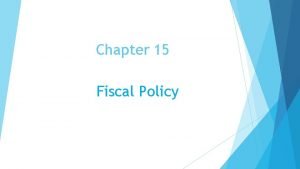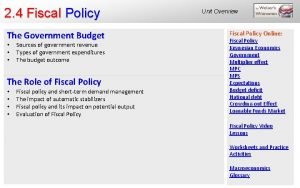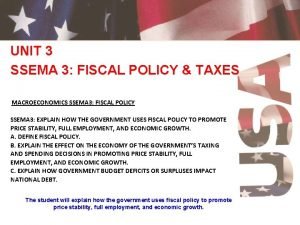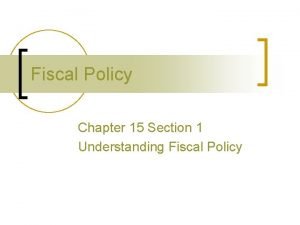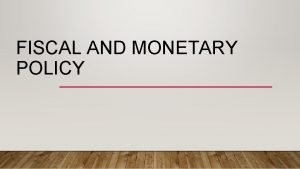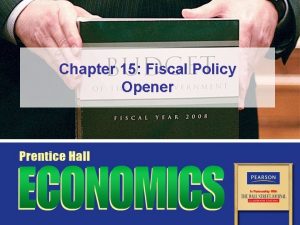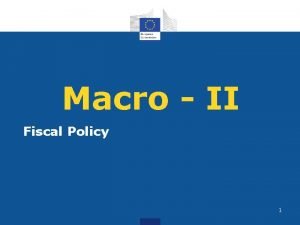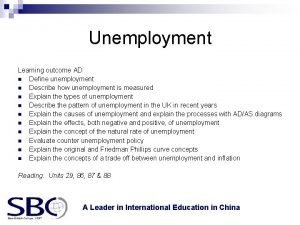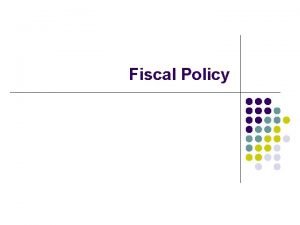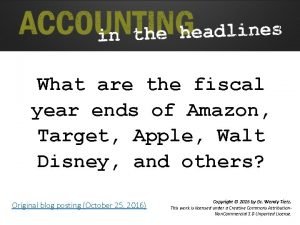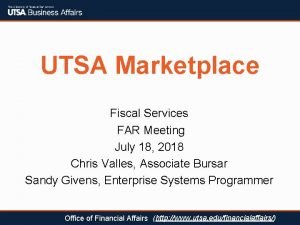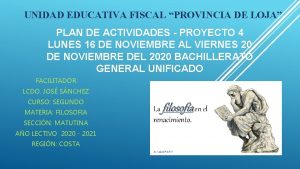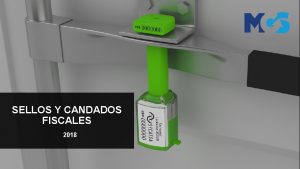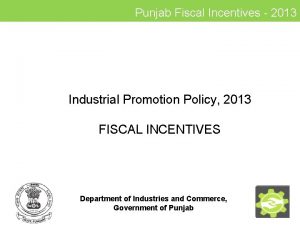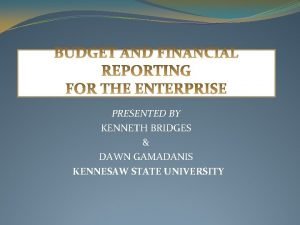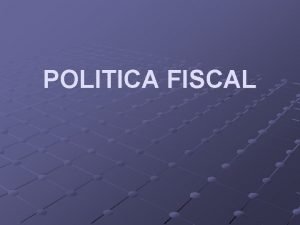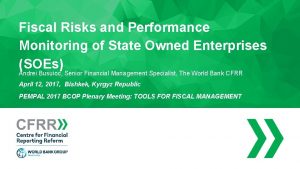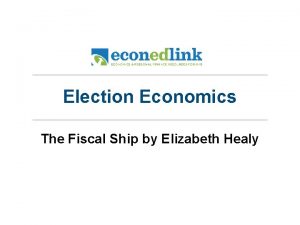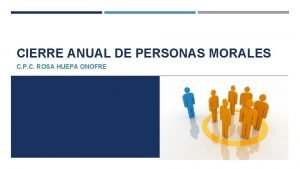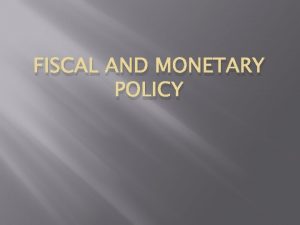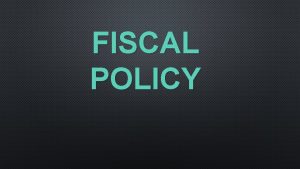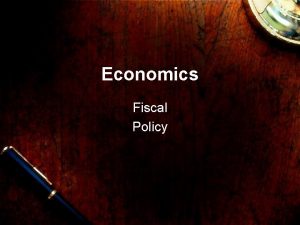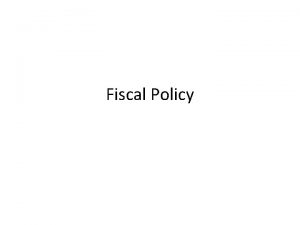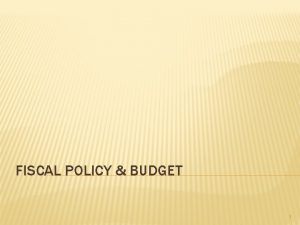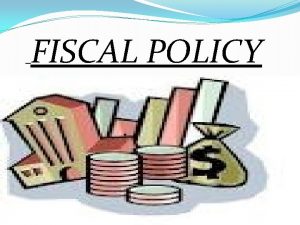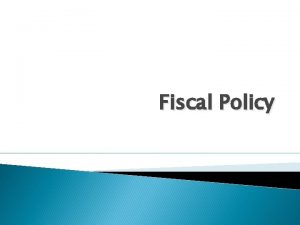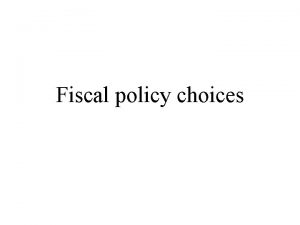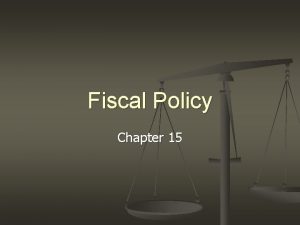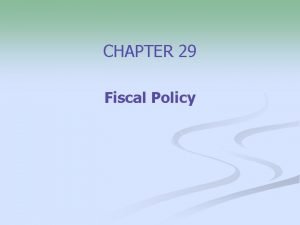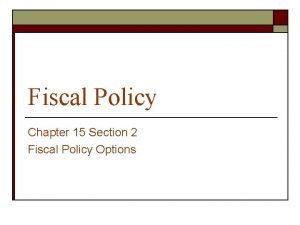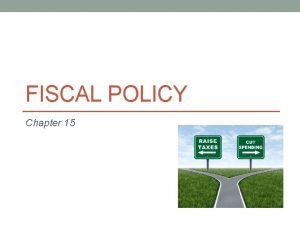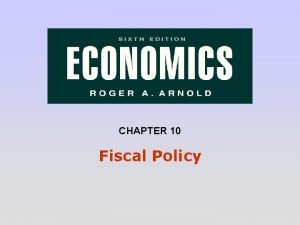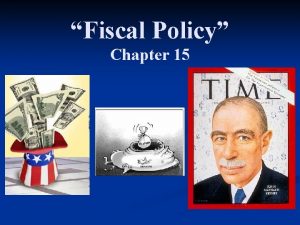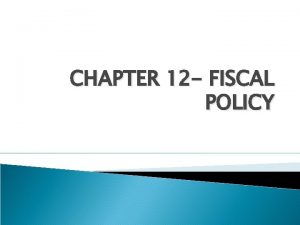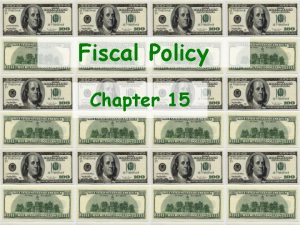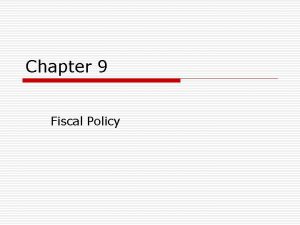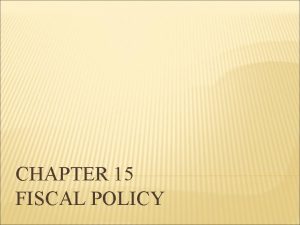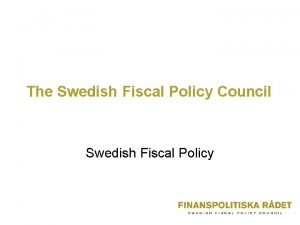Tutorial Chapter 7 Fiscal Policy 1 1 Fiscal


















































- Slides: 50

Tutorial Chapter 7 Fiscal Policy 1

1. Fiscal policy a. uses the federal government’s power of spending and taxation to affect employment, price levels, and GDP. b. uses the federal government’s power over the money supply and interest rates to affect employment, the price level, and GDP. c. can affect employment and price, but not the level of GDP. A. Fiscal policies are policies of the federal government to influence demand. During periods of inflation we would want demand to decrease, during periods of unemployment we would want demand to increase. 2

2. At any given price level (and with other things held constant) an increase in government purchase or transfer payments is most likely to decrease which of the following? a. The amount of real GDP demanded. b. The size of the federal debt. c. The amount of unemployment. d. The supply of money. C. The purpose of an increase in government spending when used as a fiscal policy is to put unemployed people back to work. 3

3. John M. Keynes is best known for advocating a. a policy of annually balancing the budget. b. deficit spending during some recessions. c. the fixed-growth-rate monetary rule. B. Before the Great Depression of the 1930’s Classical economics was the accepted believe. According the Classical thinking, the economy was always tending toward a full employment equilibrium, therefore there was no need for government intervention. Keynes believed that the economy could tend toward a less then full employment equilibrium, therefore, in this case, there was need for government intervention to move the economy to a full employment equilibrium. 4

4. If government purchases of good and services increase by $10 billion when the MPC is. 8 and the MPS is therefore. 2, then a. real GDP will increase by $16 billion. b. real GDP will increase by $20 billion. c. real GDP will increase by $40 billion. d. real GDP will increase by $50 billion. D. The formula for the multiplier is 1/MPS. Because the MPS is 2/10, which equals 1/5, the multiplier is equal to 1 divided by 1/5 or 5. Now take the multiplier and multiply it by the spending increase and you get 5 x $10 billion = $50 billion. 5

5. When automatic stabilizers kick in to partially counteract recessionary forces a. aggregate demand rises above its pre-recession level. b. the deficit falls below its pre-recession level. c. the government tends to have more of a deficit, which is intended to stimulate the economy. C. An example of an automatic stabilizer is unemployment benefits. During recessions the economy experiences insufficient aggregate demand, the unemployment benefits help to increase aggregate demand. 6

6. The balanced budget multiplier a. is greater than 1. b. is less than 1. c. is equal to 1. d. can be more or less than 1. A. It is greater than 1 because when the government increases taxes and increases spending by the same amount there is a positive stimulus effect because if citizens had the money they would save a portion of it, but when the government has the money it spends all of it. 7

7. Let’s say inflation remains stable and huge government budget deficits drive up market interest rates. This will cause a. foreign investment in the U. S. to increase. b. imports to decrease. c. the foreign trade deficit to decrease. d. the value of the dollar to depreciate relative to foreign currencies. A. As interest rates in America increase relative to interests rates in foreign countries, everything else remaining the same, will give foreigners an incentive to put their money in America to take advantage of the favorable interest rates. 8

8. Which of the following steps does not belong in a sequence reflecting the impact on international markets of increased borrowing? a. The U. S. Treasury sells securities. b. The sale of securities drives up interest rates. c. The rising value of the dollar leads to increased U. S. exports and reduced imports. C. Higher interest rates in America will attract foreign investment. But to invest in America, foreigners need American dollars, thus the demand for dollars increases in the world market, increasing the dollar’s value. Foreign products are now less expensive to Americans and American products more expensive to foreigners. 9

9. Which of the following would neutralize and offset the stimulating effect of deficit spending? a. Increased saving. b. Increased investment spending. c. Increased personal consumption expenditures. d. A decrease in taxes. A. The more people can save, the less dependent they will be on the government when they retire. 10

10. All of the following are variables that can be manipulated to affect fiscal policy except a. personal income taxes. b. government expenditures on goods and services. c. government expenditures on unemployment benefits. d. the rate of interest. D. A change in interest rates are influenced by the Federal Reserve. The Fed’s ability to increase or decrease the nation’s money supply gives it some influence as to what happens to interest rates. 11

11. A $100 billion dollar increase in government spending increases real GDP more than a $100 billion reduction in net taxes because a. some of the dollars consumers gain from the tax reduction will be saved. b. some of the dollars consumers gain from the tax reduction will be spent on services. c. consumers will spend some of it on foreign goods. A. The multiple effect is greater when the government has the $100 billion because it will spend all of it - if citizens have the money, they will save a portion of it - depending on the Marginal Propensity to Consume (MPS). 12

12. When the MPC is. 75, a decrease in net taxes of $100 billion will increase the equilibrium level of real GDP by a. $75 billion. b. $100 billion. c. $300 billion. C. -MPC/(1 -MPC) = -. 75/. 25 = -3; 3 x -$100 billion = $300 billion. 13

13. The effect of a change in net taxes on the quantity of real GDP demanded equals the resulting shift in the consumption function times a. the marginal propensity to consume. b. the marginal propensity to save. c. the autonomous net tax multiplier. C. The autonomous net tax multiplier is the ratio of a change in equilibrium real GDP demanded to the initial change in autonomous net taxes that brought it about; the numerical value of the multiplier is -MPC/(1 -MPC). 14

14. When net taxes and government purchases are reduced by the same amount a. there will be an increase in real GDP equal to the size of the reduction. b. there will be a decrease in real GDP equal to the size of the reduction. c. there will be an increase in real GDP that depends upon the size of the multiplier. d. there will be a decrease in the real GDP depending on the size of the multiplier. D. The multiplier works in reverse. If there is a reduction of X amount of spending, real GDP will decrease by a multiple of that decrease. 15

15. Which of the following is an example of fiscal policy? a. The Federal Reserve Board reduces interest rates. b. The local school board raises teachers’ salaries. c. General Electronics Corp. borrows $100 million to build anew factory. d. The federal government reduces personal income tax rates. D. Fiscal policies are policies of the federal government for the purpose of increasing or decreasing aggregate demand to fight either unemployment or inflation. 16

16. All of the following are components of the aggregate expenditure function which may be examples of fiscal policy except a. government expenditure for social security. b. consumption expenditure for appliances. c. investment expenditures for capital equipment. d. government expenditures for highway construction. A. Government spending on Social Security is simply a transfer payment; money is taken from one group and given to another group. 17

17. According to Keynesian economics, when have an unemployment problem an effective fiscal policy might be to a. reduce market prices. b. reduce interest rates. c. increase the money supply. d. increase government purchases. D. All of the above would help when we are in a less than full employment equilibrium; but only an increase in government purchases is a fiscal policy, the others are monetary policies. 18

18. According to Keynesian economics, when is fiscal policy effective in eliminating a less than full employment equilibrium? When it a. increases potential GDP. b. increases the equilibrium level of real GDP. c. increases the rate of unemployment. d. decreases the level of prices. B. Fiscal policies differ from monetary polices in that they can shift the equilibrium. With unemployment present the economy may be tending toward a point of less than full employment. By shifting aggregate demand upward, the intent is to move the equilibrium to a full employment equilibrium. 19

19. According to Keynesian economics, an appropriate fiscal policy to deal with inflation is to a. increase the rate of interest. b. increase farm subsidy payments. c. increase government purchases. d. increase personal taxes. D. Choice a is a monetary policy. An increase in personal taxes would decrease taxpayers disposable income. With the resultant decrease in demand, prices would decline. 20

20. According to Keynesian economics, when we have inflation an effective fiscal policy might include all of the following except a. increase personal taxes. b. increasing corporate taxes. c. increasing aggregate demand. d. decreasing government purchases. C. With inflation the economy could be overheated. So we want to cool it down by lowering aggregate demand. Increasing personal taxes, increasing corporate taxes, and decreasing government purchases lowers aggregate demand. 21

21. When the aggregate supply (AS) curve has a positive slope, effective fiscal policy to correct an inflation problem will a. only reduce prices. b. only reduce real GDP. c. only increase prices. d. reduce both prices and real GDP. D. Simply draw this out on a piece of paper. With an up-sloping curve and a down-sloping demand curve, a shift to the left of the demand curve will bring about a decrease in prices (vertical axis) and an decrease in real GDP (horizontal axis). 22

22. John M. Keynes influenced the use of fiscal policy in the U. S. by arguing effectively that a. that balancing the national budget at all times was sound economic policy. b. national economic forces were not necessarily adequate to move the economy towards its potential output level. c. the government did not need to stimulate output in order for the economy to achieve its potential output level. B. The biggest difference between Keynes and the Austrians was that Keynes believed that the economy could tend toward a point of less than full employment. Austrians believe that if we allowed market forces to operate we would tend toward a point of full employment. 23

23. Prior to the Great Depression of the 1930’s, the dominant fiscal policy was a. to lower taxes whenever unemployment began to increase. b. to increase government purchases whenever the nation’s output fell below its potential output level. c. to raise taxes or reduce government purchases whenever necessary to balance the federal budget. C. The Austrian economists did not believe in fiscal policies to stimulate the economy during periods of recession. However, they did believe that it was fiscally sound for the federal government to have a balanced budget. 24

24. Which of the following is the best example of an automatic stabilizer in fiscal policy? a. Spending more on national highways. b. Paying pensions to retired military personnel. c. Paying unemployment insurance benefits. d. Decreasing the supply of money. C. Automatic stabilizers go into effect during periods of unemployment and cease when the economy recovers. Only the payment of unemployment benefits in the above choices fits this description. 25

25. Automatic stabilizers a. have no effect on unemployment levels. b. have no effect on output levels. c. increase inflation. d. reduce the magnitude of economic fluctuations. D. Automatic stabilizers do not totally reverse a decline in aggregate demand (for this to happen the payments would have to equal all of a person’s loss of income), but they do slow down the downward trend. 26

26. All of the following are automatic stabilizers except a. unemployment insurance benefits. b. payments to welfare recipients. c. progressive federal income taxes. d. national defense expenditures. D. An automatic stabilizer goes into effect automatically when the economy takes a dive and is taken off when the economy recovers. Such is not the case with national defense expenditures. 27

27. Which of the following is the best example of anti-recession discretionary fiscal policy? a. An increase in government expenditures on public construction projects like bridges, dams, and roads. b. A decrease in taxes on liquor and cigarettes. c. A decrease in welfare payments. A. Discretionary fiscal policies differ from automatic stabilizers in that they are not automatic, but are up to the discretion of Congress. When the government increases spending, it is best to spend it on building our infrastructure, like roads and bridges. 28

28. The “Golden Age” of fiscal policy - that decade in which it was most in political favor and in which it seemed to work best - was a. the 1930’s. b. the 1940’s. c. the 1950’s. d. the 1960’s. e. the 1970’s. D. Keynesian economics was at its peak popularity in the 1960’s. The stagflation of the 1970’s made us realize the limitations of Keynesian policies. 29

29. Which one of the following is not one of the concerns most often expressed about the effectiveness of fiscal policy? a. The difficulty of estimating the natural rate of unemployment. b. The time lags involved in implementing fiscal policy. c. An increase in aggregate demand tends to worsen unemployment. C. An increase in aggregate demand will cause an increase in employment. 30

30. The rate of unemployment that occurs when the economy is producing its potential GDP is a. called the natural rate of unemployment. b. naturally zero. c. thought to be approximately 10%. d. equal to the rate of stagflation in most years. A. The natural rate of unemployment equals full employment. If, let’s say, five percent of the labor force would be looking for work even in the best of times, then five percent or less of unemployment would be considered full employment. 31

31. Which of the following does not hamper the effectiveness of discretionary fiscal policy? a. The difficulty of estimating the natural rate of unemployment. b. Time lags involved in enacting appropriate legislation. c. The difficulty of getting an accurate measure of the rate of inflation. d. Time lags involved in recognizing the need for fiscal policy. C. Discretionary fiscal policies would be used more for unemployment and not inflation. Even if they were used for inflation, we have no difficulty in measuring the inflation rate. 32

32. People will be likely to spend a higher percentage of any additional income when a. they believe that the increase is permanent. b. they believe that the increase is temporary. c. the increase is large. d. the increase is small. A. One of the failings of discretionary fiscal policies is that they can bring about changes that consumers will view as temporary and not permanent. It has been shown that people will base their spending habits more on what they consider their permanent income and less so on their perceived temporary income. 33

33. A temporary tax increase will fail to reduce consumption expenditures by the amount expected because a. people viewed the tax increase as permanent. b. people viewed the tax increase as temporary. c. people chose to increase their saving. d. consumption expenditures are unrelated to the level of taxation. B. This is an example of a fiscal policy that was not effective because it was perceived as temporary and not permanent. 34

34. Changes in discretionary fiscal policy (e. g. , taxes) and automatic stabilizers (e. g. , unemployment insurance benefits) can have significant unintended effects on all of the following except a. the incentive to work. b. the incentive to spend. c. the incentive to save. d. the incentive to purchase imported goods. D. Whether people purchase imported goods or not has nothing to do with discretionary fiscal policies. 35

35. Raising taxes as an element of discretionary fiscal policy is intended to reduce aggregate demand, but it can also reduce aggregate supply if a. the higher taxes lead workers to seek out a second job. b. the higher taxes cause workers to work less. c. the government purchases goods with the additional revenue. B. With an increase in taxes tax-payers disposable income decreases. If they use their disposable income as a measure of if they should work or not, workers will work less. 36

36. President Reagan and the U. S. Congress agreed on substantial changes in the federal budget in the early 1980’s. Among these changes was a. a decrease in defense spending. b. a 3% tax reduction. c. a 13% tax reduction. d. a 23% tax reduction. D. We had the largest tax decrease in history under President Reagan. The big tax decreases in the early 1980’s contributed greatly to the prosperity of the 1990’s. 37

37. The lower tax rates enacted in the early 1980’s were intended to a. increase the supply of labor. b. increase the price level. c. increase unemployment benefits. d. reduce potential GDP. A. This is what is called “supply side economics. ” By lowering taxes, people will more of an incentive to work and invest. 38

38. The Reagan experiment in supply-side economics resulted in all of the following except a. growth in employment. b. a period of sustained economic growth. c. a reduction in the federal debt. C. In the long run, a decrease in taxes will lead to an increase in real GDP do to the increase in economic growth. However, in the short run, this decrease in taxes will decrease government tax revenue and therefore add to the national debt, assuming no decrease in government spending. Government spending actually increased under Reagan because of big increases in military spending. 39

39. Large federal budget deficits a. can best be reduced by discretionary fiscal policy. b. make it difficult to use discretionary fiscal policy. c. in the mid to late 1980’s were the result of a severe recession. d. still constitute only about 1% of the GDP. B. Large deficits make it difficult for discretionary fiscal policy because the lower taxes and/or increases in government spending can add to the national debt. 40

40. The idea that non-inflationary economic growth can be induced by government programs designed to increase production and labor effort is called a. the balanced budget multiplier. b. the feedback effect. c. an automatic stabilizer. d. supply side economics. D. Keynesian economics stresses a reliance on the demand side of the equation. Supply side economics dwells on the supply side of the equation. A decrease in costs will move the aggregate supply curve to the right, thus prices decline and real GDP increases. 41

41. The depression of 1920 -1921 was a. as severe as the depression of the 1930 s. b. brief and swift. c. a case where the economy was allowed to correct the problem itself. C. We did not come in and impose all kinds of government programs as we did in the 1930 s. Some economists believe that it was government policies of the 30 s which led to the length and severity of the depression. 42

42. According the budget philosophy known as functional finance a. the budget should be balanced annually. b. surpluses should be run during periods of prosperity and deficits should be run during recessions. c. the government should not worry about whether the budget is balanced and worry instead about reaching the potential output level. C. Functional finance is a budget philosophy aiming fiscal policy at achieving potential GDP rather than balancing budgets either annually or over the business cycle. 43

43. An annually balanced budget a. is the surest path to economic stability. b. is required by the U. S. Constitution. c. accentuates cyclical swings by increasing government spending during expansions and reducing it during recessions. C. During certain recessions the problem is insufficient aggregate demand, so we would want the government to increase its spending. During expansions, the problem could be too much spending, so we would want the government to spend less. A mandated annually balance budget would hamper this process. 44

44. Which of the following statements about the tax cut enacted in 1981 during the Reagan administration is correct? a. The tax cut caused the recession of 1982. b. The tax cut of 1981 and the recession of 1982 combined to produce one of the largest peace-time deficits up to that time. c. The tax cut stimulated a large increase in economic activity and led directly to the balanced budget of 1982. B. In the long run, a tax cut will increase economics growth and tax receipts. But, in the short run, the tax cut will lower government receipts. During recessions, government outlays grows while tax receipts diminish. 45

45. The Budget Enforcement Act of 1990 a. was a package of spending cuts and tax increases designed to reduce the deficit. b. was proposed by President Clinton. c. immediately succeeded in balancing the budget. A. With concern about the deficit growing, Congress and President Bush agreed to the 1990 Budget Enforcement Act, a package of spending cuts and tax increases aimed at trimming the projected deficit. Afterward, Congress ignored its promise to cut spending and Bush lost the election largely because the tax increase he agreed to went against his “read my lips, no new taxes promise. ” 46

46. A big difference between states and the federal government is that states have to balance their budget each year whereas the federal government does not. a. True b. False A. True. Because 48 states require an annually balanced budget, they have not experienced the debt problems the way the federal government has. 47

47. When the unemployment rate increases the federal deficit a. decreases. b. increases. c. is not affected. B. Recessions bring about an increase in deficits for two reasons, first government receipts go down because unemployed people do not pay taxes, second, government spending increases as benefits increase. 48

48. The national (or federal) debt is a. the same thing as the federal deficit. b. the accumulation of all past deficits and surpluses. c. less than it was in 1946 if adjusted for inflation. d. held entirely by U. S. firms and households. B. The deficit how much we borrow in a given year. The total of the deficits adds up to the national debt. 49

END 50
 What is inflation
What is inflation Example fiscal policy
Example fiscal policy Government expenditure multiplier formula
Government expenditure multiplier formula Components of fiscal policy
Components of fiscal policy Crowding out effect of fiscal policy
Crowding out effect of fiscal policy Money market graph expansionary monetary policy
Money market graph expansionary monetary policy What is liquidity ratio in banking
What is liquidity ratio in banking Discretionary and non discretionary fiscal policy
Discretionary and non discretionary fiscal policy Instruments of fiscal policy
Instruments of fiscal policy Econ crowding out
Econ crowding out Fiscal demand side policy
Fiscal demand side policy Fiscal policy to control inflation
Fiscal policy to control inflation Contractionary fiscal policy
Contractionary fiscal policy Instruments of fiscal policy
Instruments of fiscal policy Crowding out effect
Crowding out effect Demand side fiscal policy definition
Demand side fiscal policy definition Expansionary monetary policy
Expansionary monetary policy Crowding out effect of fiscal policy
Crowding out effect of fiscal policy Example of expansionary fiscal policy
Example of expansionary fiscal policy Fiscal policy
Fiscal policy Goals of fiscal policy
Goals of fiscal policy Fiscal vs monetary policy
Fiscal vs monetary policy Goals of fiscal policy
Goals of fiscal policy Fiscal policy
Fiscal policy Unit 3 aggregate demand and aggregate supply
Unit 3 aggregate demand and aggregate supply Unit 3 aggregate demand aggregate supply and fiscal policy
Unit 3 aggregate demand aggregate supply and fiscal policy Unemployment graph macroeconomics
Unemployment graph macroeconomics Patakarang piskal
Patakarang piskal Conclusion of monetary policy
Conclusion of monetary policy Fiscal policy definition
Fiscal policy definition Meaning
Meaning Unit 3 aggregate demand aggregate supply and fiscal policy
Unit 3 aggregate demand aggregate supply and fiscal policy Chapter 33 section 4 foreign policy after the cold war
Chapter 33 section 4 foreign policy after the cold war Environmental science chapter 2
Environmental science chapter 2 Amazon fiscal calendar
Amazon fiscal calendar Utsa fiscal services
Utsa fiscal services Unidad educativa fiscal provincia de loja
Unidad educativa fiscal provincia de loja Unidad educativa provincia de loja
Unidad educativa provincia de loja Candado fiscal
Candado fiscal Fiscal incentives for industrial promotion (revised)-2013
Fiscal incentives for industrial promotion (revised)-2013 Psff
Psff Ksu fiscal services
Ksu fiscal services Jfiss digital
Jfiss digital Jfiss digital
Jfiss digital Que es deficit fiscal
Que es deficit fiscal Como actualizar una perdida fiscal
Como actualizar una perdida fiscal Perdida fiscal actualizacion
Perdida fiscal actualizacion Base imponible en una factura
Base imponible en una factura Fiscal risk example
Fiscal risk example The fiscal ship
The fiscal ship Art 97 lisr
Art 97 lisr

